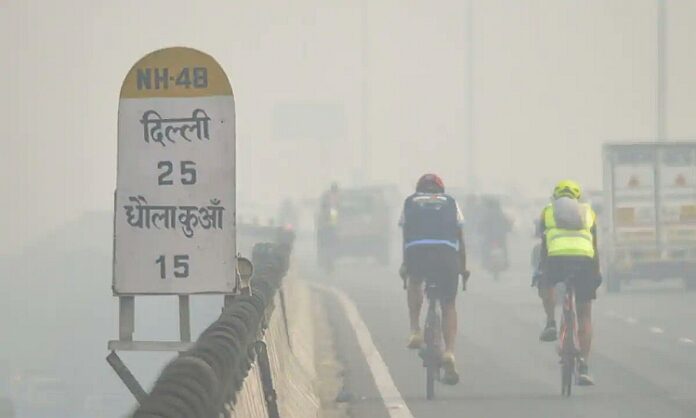New Delhi: Air quality index (AQI) of the national capital, which has plummeted to the ‘poor’ category, is likely to deteriorate to ‘very poor’ next week owing to growing incidents of stubble burning in the neighbouring states, warned the Union government’s System of Air Quality and Weather Forecasting and Research (SAFAR).
Delhi’s AQI was recorded 277 on Sunday, against 278 the day before, according to the Central Pollution Control Board (CPCB) data. SAFAR attributes the fall in AQI to unfavourable meterological conditions due to dispersion of pollutants as calm winds prevail during night.
“Additional emissions from sources such as stubble/waste burning are likely to deteriorate air quality significantly,” it added in its latest bulletin on Sunday.
Also Read: Delhi battles with toxic air despite curbs, Govt plans artificial rains
As per the CPCB norms, air quality standards are slotted into six categories—good (0-50), satisfactory (51-100), moderate (101-200), poor (201-300), very poor (301-400) and severe (401-500).
Stubble burning
Reports stated that as many as 3,376 incidences of fire and stubble burning were reported between 15 September and 19 October in Punjab, Haryana, Uttar Pradesh, Delhi, Rajasthan and Madhya Pradesh. The incidents of stubble burning or crop residue fire are roughly 200 more than those reported in the same period last year, a bulletin from CREAMS-Indian Agricultural Research Institute, which monitors satellite data on stubble, or crop residue, burning.
Also Read: Fighting air pollution: Dhanbad Municipal body puts up faux lung
Other factors for air pollution
Although stubble burning in Delhi’s neighboring states such as Punjab, Haryana and Uttar Pradesh is considered to be a major cause for the fall in AQI, there are several factors responsible for it.
A study of Pune’s Indian Institute of Tropical Meteorology (IITM) revealed that stubble burning contributed a little over 1.3% to Delhi’s air quality on 19 October, and the burning of crop residue is likely to contribute 2.3% and 2.4% to bad air quality in Delhi on Sunday and Monday, respectively.
Also Read: File reply on Bihar’s air pollution in 3 weeks: Patna HC tells BSPCB
The impact of stubble or crop residue burning could be seemingly modest as of now, the rise in trend of, especially considering that stubble burning’s contribution, is a worrying factor. The stubble burning had peaked to 1.2% on 15 October and otherwise remained below 1% earlier in the month.
On Wednesday, the Supreme Court had pulled up the Punjab and Haryana governments for their failure to take effective measures to check stubble burning, which contributes to worsening air pollution in Delhi and nearby regions during the winter months.
Also Read: Experts deliberate ways to curb air pollution impact on health
As per the CPCB data, vehicular emissions within Delhi remain the most significant contributor. Vehicular pollution was assessed to be around 14.2% on 18 October, which dropped to 11.2% on Saturday. Projections indicate it could decrease slightly further to 10.5% during subsequent days.
Major sources of air pollution not known
IITM study, however, revealed that sources for a significant amount of pollution, ranging between 32% and 44%, is yet to be ascertained, emphasising the complexity of effectively addressing Delhi’s air quality challenges. This ‘unidentified’ variable remains a critical area for research, as the city grapples with escalating pollution.
Also Read: Delhi-NCR authorities invoke GRAP-II stage, as AQI turns very bad
Waking up to the issue, the Delhi Pollution Control Committee has already implemented a complete ban on the manufacturing, storage, sale, and use of all types of firecrackers in the national capital until 1 January, next year. Similarly, authorities in Punjab have imposed a ban on the bursting of crackers, and in Haryana’s Gurugram, green crackers will be allowed for Diwali celebrations.
The Commission for Air Quality Management has already activated Stage-I of the Graded Response Action Plan (GRAP), a series of measures to combat air pollution in the National Capital Region. The government is also considering cloud seeding as an emergency measure to reduce pollution.




